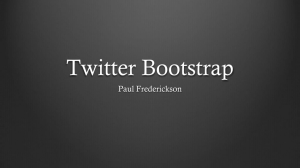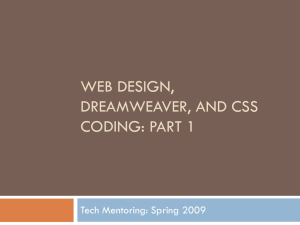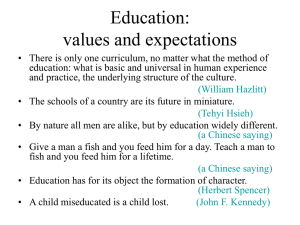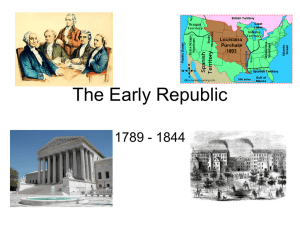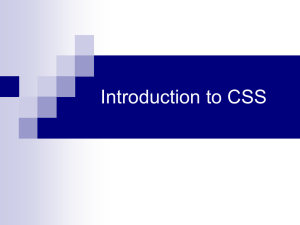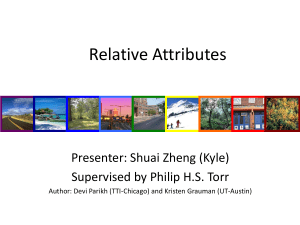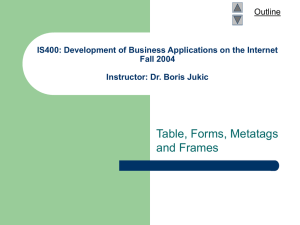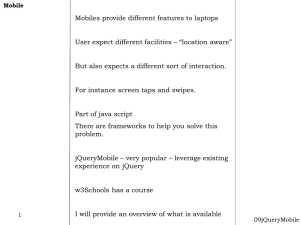The world wide web - Department of Computing
advertisement
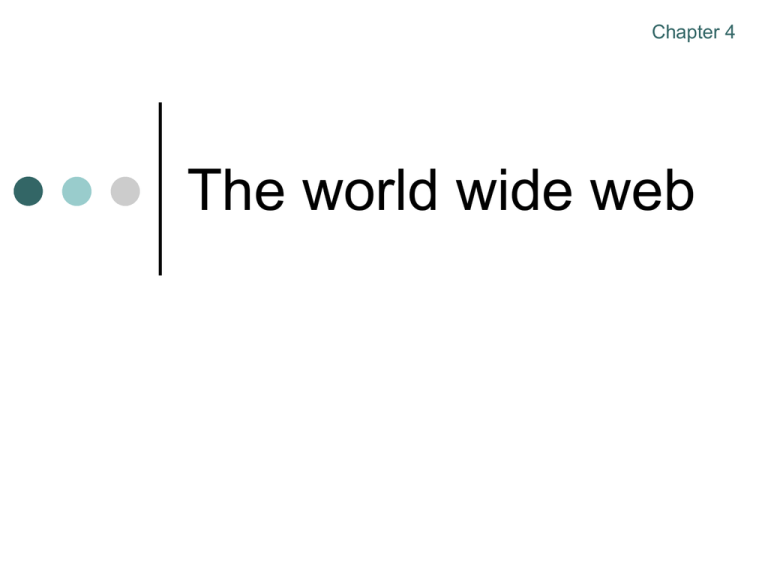
Chapter 4
The world wide web
Learning outcomes
Explain in general terms how web
documents are transferred across the
Internet and
What processes are triggered when you
click on hyperlink
Code web pages using HTML and XHTML
using style sheets.
Explain why it is advisable to use XHTML
rather than HTML
Describe some technologies available for
dynamic web pages
Essential Reading
Joe Casad, Teach yourself TCP/IP, Ch. 17
William Buchanan, Mastering The Internet,
Ch. 6-8
Introductory materials on HTML & XHTML
either a text book such as
John Shelly, HTML AND CSS explained, or
http:/www.webMonkey.com
http://www.w3schools.com
Additional reading
William Buchanan, Mastering The Internet, Ch.
9-10
Andrew Tanenbaum, Computer Networks, Ch.
7.3
Douglas Comer, Computer Netwoks and
Networking, ch. 32-33
Chuck Masciano and Bill Kennedy, HTML and
XHTML the definitive guide, for reference
http://www.pcnetworkadvisor.com
Mike Lewis, “Understanding Javascript”, JuneJully 2000
How the web works
The client-server model
Client and server operate on machines which are able
to communicate through a network
The server waits for requests from a clients
Server receives a requests from a client
• Performs a the requested work
• Or lookup the requested data
• And send a response to the client
Servers: file servers, web servers, name servers
Clients: browsers, email clients
url format
<scheme>://<server-domain-name>/<pathmane>
<scheme> which protocol to use
• http: in general
• file: which tells the client document is in a local machine
• ftp: file transfer protocol
<server-domain-name> identifies the server system
• i.e. www.doc.gold.ac.uk
<pathname> tells the server where to find the file
http://doc.gold.ac.uk/~username/index.html
Web browsers and servers
A browser: is a program that can retrieve
files from the world wide web and render
text, images, or sounds encoded in the files.
i.e. IE, Nescape, Mozilla
A web server: is an application which waits
for client requests, fetches requested
documents from disk and transmits them
the client.
i.e Apache
What happened when you
click on hyperlink?
Determine URL and extract domaine name.
Use the name server to get IP address
(DNS)
Make a TCP connect to port 80
And send a request for a web page once
the server has accepted to connection.
The server send the file and releases the
TCP connection
The client displays the document.
Other possibilities
The steps in the previous slide are for displaying a static
web page from a remote machine.
Other possibilities are:
Page is loaded from a local system
• no tcp connection
• url begin with file://...
The page is dynamically generated by a client-side script
• No tcp connection
The page is dynamically generated by a server-side script:
The server may carry out other functions
• Secure server
• Check user’s identity if they are authorised to access a particular
resources
Stateless connection
Both client and server release TCP connection after a
page has been transferred.
HTTP1.0 is stateless
Connections are not persistent
There is no indication to the server whether new
transactions involve the same client
HTTP 1.1 is persistent
By keeping track of the client IP addresses
However, there is no way of identifying a repeated
visits to the site by the same user.
Futhermore, ISPs reallocate IP addresses to dial-up
customers as new user dial in.
Cookies
Request the browser to store a small data
file (cookie) on the users hard disk.
Which can serve to identify users only.
For instance it could contain a key into a
database on the server machine.
Most browsers nowadays allow you to
decide whether or not you want cookies on
your machine.
Introduction to HTML
What is an HTML File?
HTML stands for HyperText Markup Language
An HTML file is a text file containing small markup tags
The markup tags tell the Web browser how to display the page
An HTML file must have an htm or html file extension
An HTML file can be created using a simple text editor
Internet - Services
Email & MIME (Multipurpose Internet Mail Extensions)
text (text/html), image, video, etc.
Telnet & ssh
FTP – File Transfer Protocol
Gopher
IRC – Internet Relay Chat
Newsgroups
WWW – World Wide Web
HTTP (Hypertext transfer protocol) uses a QuestionAnswer-Scheme, i.e. a browser sends a request und gets a
response from a server. Note the server does not send out
anything without a request.
Markup languages
Suppose we have a document containing only plain text
We tag certain parts of the document to indicate what
they are and how they should be formatted
This procedure is called marking-up the document
Tags are usually paired:
• e.g. <title>My Memoirs</title>
A pair of tags plus their content constitute an element
Un-paired tags are called empty tags
Markup languages
Physical vs Semantic markup
physical refers to appearance (style) on the page
semantic refers to structure and meaning
HTML is the HyperText Markup Language
HTML is based on SGML (Standard Generalised Markup
Language) which is more complex
HTML has a fixed set of tags but is constantly evolving,
but newer versions are downward compatible
Markup languages
HTML places primary emphasis on structure
paragraphs, headings, lists, images, links,
….
HTML places secondary emphasis on style
(CSS)
fonts, colours, ….
HTML does not label the meaning of the text
(XML)
A basic document
Every document should start with the
following line
<!DOCTYPE html PUBLIC “-//W3C//DTD HTML 4.0 Transitional//EN”>
• There are three required elements, defined by the tags <html>,
<head> and <body>
<html>
<head>
<title>My Home Page</title>
</head>
<body>
<h1>Welcome</h1>
</body>
</html>
Basic structure elements
•
first and last tags
The HEAD section
must come before the BODY section
contains generic information about the document
Elements specified in the HEAD section can include
– title, link, script, style
The BODY section
contains the content of the document (text, images
etc)
this content is structured by other tags
Block elements
•
•
•
•
Block elements define sections of text, usually preceded by
a blank line
<p></p> - paragraph
<h1></h1>...<h6></h6> - headings
<pre></pre> - preserve (original format)
<blockquote></blockquote> - indented text
<div></div> - division
used to identify a section of the document that may be
subject to special formatting (for example, using
stylesheets).
Paragraphs
Paragraphs: <p>...</p>
force a break between the
enclosed text and the text
surrounding it
the tagged region of text may be
subject to special formatting
<p align="center">Here is
another paragraph</p>
– align is an attribute of the
paragraph tag
– center is the value of the align
attribute
<p>here is a piece of
text that has been
placed inside a
paragraph</p>
<p align="center">Here
is another
paragraph</p>
Headings
Six levels of importance
<html>
<h1>...<h6>
<head>
Use headings to divide
<title>Headings</title>
document into sections
</head>
<body>
<h2>Chapter 1</h2>
<h3>1. Introduction</h3>
This is the introduction
<h3>2. Next section</h3>
This is the next section
<h4>2.1 A subsection</h4>
This is a subsection
</body>
</html>
Element relationships
The elements marked by tags form a hierarchy
The root element is html (marked by <html>...</html>)
It usually has two children: head and body
each of these are further subdivided
There are rules for which elements can contain other elements
e.g. headers cannot contain headers
see http://www.w3.org/ for a full list of rules
Elements must not overlap each other
we cannot have: <h1>...<a..> ... </h1>...</a>
we can have: <h1>...<a..> ... </a>...</h1>
Inline descriptive elements
Descriptive elements affect the
appearance of text depending on
how the text is described
• <em></em> emphasis, usually with
italics
• <strong></strong> strong,
usually with bold
• <cite></cite> citation, usually in
italics
• <code></code> usually results in
monotype spacing
<body>
A <em>fascinating</em>
subject that I
<strong>must</strong>
understand
</body>
Inline explicit style elements
•
•
•
•
•
•
•
•
•
<boldface></boldface>
<big></big> bigger font than surrounding text
<small></small> smaller font than surrounding text
<i></i> italics
<s></s> strikethrough
<sub></sub> subscripts
<sup></sup> superscripts
<span></span> delimits text for stylesheet control
<div></div> delimits blocks of text for stylesheet control
Inline explicit style elements
<font> attributes
• face - name of font (must be installed)
– "arial", "times", "verdana", "helvetica"
• size - absolute size (1-7), or relative to previous text
– "2", "5", "7", "+1", "-2"...
• color - hexadecimal RGB, or a named color
– "3399dd", "blue", "red"
• weight - boldness from 100, 200, ..., 900
– "100", "300", "900"
e.g.
<font face="arial" size="+1" color="pink" weight="300">
Unordered lists
•
Unordered lists <ul>...</ul>
<li>...</li> for the list
elements
each item has a bullet
some normal text
<ul>
<li>apples</li>
<li>oranges</li>
<li>pears</li>
<li>bananas</li>
</ul>
Ordered lists
•
Ordered lists <ol>...</ol>
<li>...</li> for the list elements
each item has a number
some normal text
<ol>
<li>apples</li>
<li>oranges</li>
<li>pears</li>
<li>bananas</li>
</ol>
Definition lists
•
•
•
<dl></dl> The enclosing tags
<dt></dt> The definition term
<dd></dd> The definition
<dl>
<dt>MIME</dt>
<dd>
Multipurpose...
</dd>
<dt>FTP</dt>
<dd>
File transfer...
</dd>
<dt>TCP</dt>
<dd>
Transmission...
</dd>
</dl>
Nested lists
A list may contain another list
The inner list is nested inside the
outer list
<body>
<ol>
<li>apples</li>
<ul>
<li>red</li>
<li>green</li>
</ul>
<li>oranges</li>
<li>pears</li>
<li>bananas</li>
</ol>
</body>
Comments
Comments are delimited by <!-- and -->
<!– this is a comment -->
Comments may span multiple lines
<body>
<!-this is
a comment
-->
</body>
Horizontal lines
To insert a horizontal line to
divide up parts of a document
we use the empty tag <hr>
Attributes: align, size (in
pixels), width (in pixels or
percentage), noshade
<body>
<h1>Chapter 1</h1>
<hr align="center" size="3" width="50%" noshade>
<h2>Introduction</h2>
</body>
Special characters
Some characters such as <, >, "
and & have special meanings.
To prevent them being interpreted
as HTML code, they must be
written as follows: &lt; &gt;
&quot; &amp;
Blank space is normally ignored
in HTML. To include a space in
your document use: &nbsp;
<body>
A <em> &lt;
fascinating &gt; </em>
subject that I
<strong>m&nbsp;u&nbsp;
s&nbsp;t</strong>
understand
</body>
Links
The link (anchor) element <a>...</a> provides hypertext links
between
1. different documents (using a URL)
2. different parts of an individual document
User selection of the link (hot spot) results in
1. retrieval and display of the designated document
2. movement to relevant part of same document
<body>
The Department of
<a href="http://www.doc.gold.ac.uk/index.html"> Computer
Science</a> is a very ....
</body>
Link with URL
Example:
<body>
The Department of
<a href="http://www.doc.gold.ac.uk/index.html">
Computer Science</a> is a very ....
</body>
The href attribute gives the
URL of the target page
The text between the tags is
highlighted – selecting it
activates the link
Relative addressing
The
previous example gave the full path name, known as the absolute address
<a href="research.html">Research</a>
<a href=“./pub.html">Publications</a>
<a href="../../index.html">Computer Science home</a>
• The ‘root’ directory for the link is assumed to be the
directory containing the parent page of the link
Images
Images are included using the empty tag <img>
Example:
<img src="mypicture.gif" alt="my picture">
The src attribute specifies the file containing the image
absolute or relative path names can be used (see
notes for links)
The alt attribute specifies the text to be displayed if the
image is not viewed
some users choose not to display
images (for faster download)
also used for compatibility with older
browsers
Image attributes
The size attributes control the size of the image
<img src="cat.gif" height="60" width="90" align=“top” alt="cat">
The align attribute controls the vertical location of the image,
relative to the line of text
– align="top"
top of image aligned with top of text
– align="middle" centre of image aligned with centre of text
– align="bottom" bottom of image aligned with baseline of text
The align attribute also controls the horizontal location of the image,
relative to the line of text
– align="left"
image aligned with left margin
– align="right" image aligned with right margin
Links with images
A link element can include an image instead of text
both images and text can be included if required
<body>
Enter my world of cats <a href="cats.html"><img
src="cat.gif" height="60" width="60" align="middle"
alt="cat"></a>
</body>
Colour
Colours are specified with hexadecimal
numbers for the red, green and blue primary
colours, preceded by a “#”.
To set the background colour of a web page
<body bgcolor="#994422">
Colour – RGB Model
– #ff0000 (red),
– #00ff00 (green)
– #0000ff (blue)
– #ffff00 (yellow)
– ...
– #3395ab (a pastel blue)
Colour
<body text="#994422">
To set the colour of all text on a page
• In the body element, the colour of link text can be controlled with the
following attributes:
– link
for an un-visited link
– vlink
for a visited link
– alink
for a link that is currently selected by the mouse
• Example
<body text="#000000" link="#0000ff">
Colour
To set the colour of an individual piece of text use the font element
(or preferably stylesheets – see later)
<body bgcolor="#3395ab">
Text in quotes <font color="#ff0000">"such as
this"</font> has a different colour
</body>
Colour names
Netscape and Internet Explorer allow textual names for
colours instead of hexadecimal
This is OK provided the page is not looked at by a
browser that does not support colour names
For example
<body bgcolor="gray" text="black" link="blue">
Background patterns
Rather than a uniform color
You can give the background of web
page a pattern as follow:
<body background="tileimage.gif">
Forms
Server-based programs may return data to the
client as a web page
Client-side scripts can read input data
To validate the data, prior to sending to
server
To use in local processing which may output
web page content that is displayed on the
client
Example applications
Questionnaires to provide feedback on a web site
e-commerce, to enter name, address, details of purchase
and credit-card number
request brochures from a company
make a booking for holiday, cinema etc.
buy a book, cd, etc
obtain a map giving directions to a shop
Run a database query and receive results (an important
part of e-commerce)
Input types
•
•
•
•
•
•
•
•
•
•
•
•
text
checkbox
radio
select
textarea
password
button
submit
reset
hidden
file
image
(buttons)
(options)
The method and action
attributes
• The method attribute specifies the way that form data is sent to the
server program
– GET appends the data to the URL
– POST sends the data separately
• The action attribute specifies a server program that processes the
form data (often as a URL)
<body>
<form method="POST" action="comments.php">
<h2>Tell us what you think</h2>
<!-- etc -->
</form>
</body>
The input element:
type="text"
• The type attribute specifies the
type of user input
• The name attribute gives an
identifier to the input data
<form method="POST" action="comments.php">
<h2>Tell us what you think</h2>
Name <input name="name" type="text" size="20"><br>
Address <input name="address" type="text" size="30">
</form>
The input element:
type="checkbox"
• The name attribute is used to
define a set of checkboxes
• The value attribute identifies
the individual checkbox
• If the checked attribute is set
the box is initially checked
How did you hear about this web site?<br>
A friend
<input type="checkbox" name=“name" value="friend"><br>
Search engine
<input type="checkbox" name=“name" value="engine"><br>
The input element:
type="radio"
• Radio buttons are similar to
checkboxes, but only one can be
selected
• To select a button by default, use
the checked attribute (for one
button only)
How did you hear about this web site?<br>
A friend
<input type="radio" name=“name" value="friend"><br>
Search engine
<input type="radio" name=“name" value="engine"><br>
<!– etc -->
The input element:
type="button"
• The name attribute uniquely identifies
a button
• The value attribute gives a label to
the button
• Actions can be associated with
buttons using JavaScript
– see later
Do you want to receive any further information:<br>
<input type="button" name="yes" value=" Yes ">
<input type="button" name="no" value=" No "><br>
The input element:
type="submit/reset"
• type="submit"
– clicking this button sends the
form data to the program
(URL) specified in the
action attribute of the form
• type="reset"
– clicking this button clears all
data entered so far
Thank you<br>
<input type="submit" name="send" value="Send">
<input type="reset" name="clear" value="Clear"><br>
The input element:
type="password/file/hidden"
• type="password"
– similar to type="text" except that the input is
echoed with asterisks (so not visible)
• type="file"
– provides a file dialogue box to specify a file that is
sent to the server
• type="hidden"
– similar to text input, but the value attribute is used to
specify data that is to be sent to the server. Nothing
appears on the screen.
– The data might be set by a server program to keep
track of the details of a particular transaction.
The textarea element
• Used for multi-line text input
• The size of the input area is
specified with the cols and
rows attributes
• Any text placed inside the
element appears in the input
area (this can be deleted).
Please write your comments:<br>
<textarea name="comments" rows="5" cols="20">
put text here
</textarea>
The select element
• The select element provides a
menu of options
• An option can be selected by default
using the selected attribute
(otherwise the first in the list is
initially selected)
How do you rate this site?<br>
<select name="rating">
<option>Good
<option selected>Bad
<option>Ugly
</select>
Tables
Tables
provide a means of
organising the layout of data
A
table is divided into rows and
columns: these specify the cells
of the table
Tables
•
<table>
element
main
•
<tr>
table row
•
<th>
table header
•
<td>
table data
<table border="1">
<tr>
<th>Name</th>
<td>A B Morgan</td>
<td>D P Jones</td>
</tr>
<tr>
<th>Course</th>
<td>Fishing</td>
<td>Sailing</td>
</tr>
<tr>
<th>Year</th>
<td>8</td>
<td>5</td>
</tr>
<tr>
</table>
Rows and
Columns
Cells can span
multiple columns
and multiple rows
with the colspan
and rowspan
attributes
<table border="1">
<tr>
<th colspan="2">Name</th>
<th>Course</th>
<th>Year</th>
</tr>
<tr>
<td>A B</td>
<td>Morgan</td>
<td rowspan="2">Fishing</td>
<td>5</td>
</tr>
<tr>
<td>D J</td>
<td>Jones</td>
<td>8</td>
</tr>
<tr>
</table>
The align and width attributes
The align
attribute
determines the
position of the text
within a cell
The width
attribute
determines the
width of the row
relative to the
table
<table border="1" align="center">
<tr>
<th colspan="2" width="60%">Name</th>
<th rowspan="2">Course</th>
<th rowspan="2">Year</th>
</tr>
<tr>
<th>Last</th>
<th>Init.</th>
</tr>
<tr>
<td>Morgan</td>
<td>AB</td>
<td>Fishing</td>
<td align="center">5</td>
</tr>
<!– etc -->
Table attributes
Table attributes
•
•
•
•
•
•
align alignment relative to the page
width in pixels or percentage of page width
border - width of border (pixels)
cellspacing separation between cells (pixels)
cellpadding - space around data inside cell (pixels)
bgcolor - background colour (inside cells)
Furthermore
• The <caption> element puts a title above the table
Table attributes
<table border="3" align="center" cellspacing="6"
cellpadding="6" bgcolor="cyan">
<caption>
<h2>Course Data</h2>
</caption>
<tr>
<th>Name</th>
<th>Course</th>
<th>Year</th>
</tr>
<tr>
<td>A B Morgan</td>
<td>Fishing</td>
<td>5</td>
</tr>
<!– etc -->
Frames and Framesets
A frameset partitions a web browser
window so that multiple web
documents can be displayed
simultaneously.
Example application: To maintain a
permanently visible directory of links
within your site, while also displaying
one or more selected documents from
the site.
Framesets
<html>
<head><title>Frames 1</title></head>
<frameset cols="140,*">
<frame name="navF" src="navigation.html">
<frame name="mainF" src="intro.html">
</frameset>
</html>
The frameset element replaces
the body element
•
frameset has attributes cols or
rows, defined in terms of pixels,
percentage(%) or unspecified (*)
this splits the window into two
or more columns or rows
Frame attributes
<frameset cols="140,*">
<frame name="navF" src="navigation.html">
<frame name="mainF" src="intro.html">
</frameset>
The name attribute uniquely identifies the
frame. It may be used as the target in an
anchor (<a>) element
•
The src attribute specifies the web page to
be placed in the frame initially (it may
subsequently be overwritten)
Frame attributes
<frameset cols="140,*">
<frame name="navF" src="navigation.html">
<frame name="mainF" src="intro.html">
</frameset>
•
The scrolling attribute ("auto", "yes",
"no") specifies whether the frame is to have
scroll bars
•
The frameborder attribute ("0", "1")
specifies whether the frame is to have a
border
navigation.html
The anchor tag has a target attribute
takes the name of the frame used to display
the information
All anchors below are targeted to the
"mainF" frame
<html><head><title>Navigation Bar</title></head>
<body><center>
<a href="course.html" target="mainF">HTML Course</a><br><br>
<a href="paragraph.html" target="mainF">Paragraphs</a><br>
<a href="headings.html" target="mainF">Headings</a><br>
<a href="ulists.html" target="mainF">Unordered lists</a><br>
<a href="olists.html" target="mainF">Ordered lists</a><br>
<a href="nlists.html" target="mainF">Nested lists</a><br>
<a href="intro.html" target="mainF">Home</a><br>
</center></body>
intro.html
A simple document which is initially placed in
the "mainF" frame
This is replaced when a user clicks on a link
in the "navF" frame
<html>
<head><title>Internet Computing</title></head>
<body>
<h2>Welcome to the HTML Course</h2>
<p>
<h4>Please select the subject of...</h4>
</p>
</body>
</html>
Nested framesets
<html>
<head><title>Frames 2</title></head>
<frameset cols="140,*">
<frame name="navF" src="navigation.html">
<frameset rows="30%,70%">
<frame name="upperF" src="intro.html">
<frame name="lowerF" src="course.html">
</frameset>
</frameset>
</html>
Noframes
• Some browsers cannot process frames. Alternative
content should be provided using the noframes element
<html>
<head><title>Frames 1</title></head>
<frameset cols="140,*">
<frame name="navF" src="navigation.html">
<frame name="mainF" src="intro.html">
</frameset>
<noframes>
<body>
Something here for browsers not supporting frames
</body>
</noframes>
</html>
Stylesheets
One of the most important functions of HTML is its ability
to separate the content and presentation of a web
document
Aspects of the document presentation include
• positioning on the page
• choice of fonts
• colours and backgrounds
• borders
Styles
A style is a set of formatting instructions that can be
applied to a piece of text.
Styles can be defined
Within a single HTML tag – Inline styles
In the <head> section, and applied to the whole
document – Global styles
In external files, and can be applied to any
document by including the URI of the file –
Stylesheets
Inline styles
Every tag has a style attribute
This can be assigned a style definition
A style definition is a list of property-value pairs
a property is separated from its value by a colon
property-value pairs are separated by semi-colons
the list is delimited by quotation marks
A property-value pair is also called a declaration
Inline styles only affect the text contained in the tag
<h1 style="color:#2255ff; border:ridge">Inline styles</h1>
Inline styles
<body>
<h1 style="color:blue; border:ridge">
Inline styles</h1>
<p style="margin-left:10%; background:#ffffcc">
some text . . . some text
</p>
<body>
•
The heading is boxed with
the text displayed in blue
•
The paragraph is indented
by 10% (from the left) and
has a cream background
Global styles
A style can be defined in
the head of the document
using the <style> tag
The style declaration is
placed inside a comment
so that it can be ignored
by older browsers
Each style rule consists of
the name of an element
(selector) followed by a
list of property-value pairs
enclosed in curly brackets
<head>
<title>Styles</title>
<style>
<!-h1 {
color: red;
border: thin groove;
text-align:center;
}
-->
</style>
</head>
<body>
<h1>Simple styles</h1>
</body>
Example
<head>
<style>
<!-h1 {
color: red;
border: thin groove;
text-align:center;
}
p {
margin-left: 10%;
border: ridge;
background: #ee8822;
}
-->
</style>
</head>
<body>
<h1>Simple styles</h1>
<p>some text . . . </p>
</body>
• A global style applies to
every instance of the
corresponding element
in the document
Stylesheets
Styles can be declared in separate files called stylesheets.
A stylesheet is linked to a web document by including the following
line in the head section
<link rel="StyleSheet" type="text/css" href="URL">
•
•
•
•
rel specifies the type of link being used
href specifies a hyperlink to the stylesheet file
type specifies the MIME type of the data
text/css describes the “cascading style sheets” type
Multiple stylesheets
The first stylesheet is included using the <link> tag
Any further stylesheets have to be imported
The @import command is placed inside a comment
<head>
<title>Stylesheets</title>
<link rel="StyleSheet" type="text/css"
href="http://www.abc.com/mainstyles.css">
<!–
@import
url(http://www.abc.com/deptstyles.css)
url(mystyles.css)
-->
</head>
Cascading stylesheets
Multiple stylesheets can be included in a document
Styles defined in the first stylesheet are overridden by
corresponding styles defined in the second stylesheet
the stylesheets are said to cascade
Example
– mainstyles.css – the company's stylesheet
– deptstyles.css – the department's stylesheet
– mystyles.css – the user's stylesheet
If the stylesheets are included in this order, the user's
style definitions will override the department styles,
which in turn will override the company styles
Cascading stylesheets
Different stylesheets for different media, platforms and
systems
– Font size in CSS does not yield sam results on
different screens. On Print Media 10pt size fonts are
always the same size because the size of a pt is well
defined. The conversion of pt to px (pixel) is different
on Windows, Linux or Mac OS X platforms.
– Browser allow to customize layout and fonts
Style rules
A style rule has two parts
a selector (element name) and a set of declarations
The selector associates the style rule with a HTML tag of
the same name
• Each declaration has two parts:
– a property and a value
• For readability, each declaration
should be placed on a separate
line
selector {
property:
property:
property:
property:
}
value;
value;
value;
value;
Style rules
• Some properties can be given multiple values
– The browser first looks for the "Book Antiqua" font
– If this is not on the system, it looks for the Times font
– Last resort: the browser uses the generic serif font
body {
background-color: lightgreen;
}
h1 {
color: lightgreen;
background-color: blue;
font-family: "Book Antiqua", Times, serif;
border: thick groove #9baab2;
}
Properties and values
Fonts
•
font-family: <family name> [<generic family>]
•
font-style: normal|italic|oblique
•
font-weight: normal|bold|bolder|lighter
•
font-size: small|medium|large|smaller|larger
Backgrounds and colours
•
color: <value>
•
background-color: <value>|transparent
•
background-image: URL|none
Properties and values
Text
• text-decoration:
none|underline|overline|line-through
• text-transformation:
none|capitalize|uppercase|lowercase
• text-align: left|right|center|justify
• text-indentation: length|percentage
Example: To remove underlining on links:
a:link, a:visited, a:active{text-decoration: none}
Properties and values
Boxes
• margin: length|percentage|auto {1,4}
•
border-width: thin|thick|medium|length {1,4}
•
padding: length|percentage {1,4}
•
border-color: value {1,4}
•
border-style:
none|dotted|dashed|solid|double|groove {1,4}
•
ridge: value {1,4}
•
width: length|percentage|auto
•
height: length|auto
Properties and values
Position
• location: absolute|relative|fixed
– absolute: relative to upper left corner of window
– relative: relative to the last item
– fixed:
does not move when the page is
scrolled
•
left: distance from left border of window (pixels, %)
•
top: distance from top border of window (pixels, %)
Classes
Simple style rules change the appearance of all
instances of the associated element
A class is a style definition that may be applied as and
when we choose
if we don't want the styles, we don't have to use them
Simple classes are applied to a single type of element
Anonymous classes can be applied to any type of
element
Simple classes
</head>
<style>
<!-h1.fred {
color: #eeebd2;
background-color: #d8a29b;
border: thin groove #9baab2;
}
-->
</style>
</head>
<body>
<h1 class="fred">A Simple Heading</h1>
<p>some text . . . some text</p>
</body>
Anonymous classes
</head>
<style>
<!-.fred {
color: #eeebd2;
background-color: #d8a29b;
border: thin groove #9baab2;
}
-->
</style>
</head>
<body>
<h1 class="fred">A Simple Heading</h1>
<p class="fred">some text . . . some text</p>
</body>
white
CSS Classes…cont.
TD {font-face : sans-serif; font-size : 12pt}
.even {background-color : #FFFFFF}
.odd {background-color : #CCCCCC}
In your HTML code for the table:
you simply reference the class to invoke the style:
•
•
<td class=“even”>display this text with a white background
</td>
<td class=“odd”>and this text with a grey background
</td>
grey
IDs
<head>
<style>
<!-#list1 {
color: blue;
background: cyan;
text-decoration: underline;
border: thin groove red;
}
-->
</style>
</head>
<body>
<ul id="list1">
<li>First</li>
<li>Second</li>
<li>Third</li>
</ul>
</body>
• Classes specify styles for
particular instances of an
element
• IDs specify the style of a
single element
• IDs allow the
element to be
identified by other
elements on the
page
<DIV> & <SPAN> are your friends
<div> and <span> tags allow you define exceptions to the general
rules of your body text…and they are helpful tools for
document designers and web developers
<div> is usually used to designate styles for block elements that
should stand apart from the body text…like callout quotes.
Everything inside a <div> tag takes on the <div>
attributes…and you can specify classes and ids for <div>
too!
Divisions and spans
Rather than applying styles to an element itself,
we wrap the element in
a div element (usually for block elements), or
a span element (usually for inline elements)
Any required formatting can then be applied to
the <div> or <span> element.
Div and span elements become part of the
document
In particular, each can have class and id
attributes
Divisions
<head>
<style>
<!-.myclass {
color: blue;
background: cyan;
text-decoration: underline;
border: thin groove red;
}
-->
</style>
</head>
<body>
<div class="myclass">
<h2>A Simple Heading</h2>
<p>some text . . . </p>
</div>
</body>
Styles can be applied
to blocks of HTML
code using div
Spans
<head>
<style>
<!-.myclass {
color: red;
background: cyan;
text-decoration: none;
}
-->
</style>
</head>
<body>
<span class="myclass">
<h2>A Simple Heading</h2>
<p>some text . . . </p>
</span>
</body>
spans
are
similar to
divisions
Layers
The browser maintains a stack of layers, each containing
text, images etc. The browser displays layers on top of
each other (in order).
The <div> tag has the following attributes
– z-index: the number of the layer containing the
division
– left and top : the location (top-left corner) of the
division in pixels
– width and height: the size of the division in pixels
– position: absolute or relative
Layers
Layers can be manipulated using JavaScript to create
Dynamic HTML pages
Layers can also be used to organise page content
<body>
<div style="z-index:2; left:100px; top:50px; position:absolute;
background-color:red; font-size:30">
<p>THIS STUFF IS ON TOP</p>
</div>
<div style="z-index:1; left:10px; top:10px; position:absolute;
background-color:yellow; font-size:56">
<p>BACKGROUND STUFF</p></div>
</body>
Summary
By now you should be able to use:
Tables
Frames
Stylesheet – CSS
Inline style
Embedded style
External style
Typical exam question
explain why is it important to separate
the content from the style.
what is CSS?
State three ways in which styles can
be used. And explain the advantages
and disadvantages of each one.
Next
Look at the disadvantages of html
XML
Well formed vs valid xml document
XHTML vs HTML
DHTML
Useful sites
http://www.w3schools.com/
http://www.w3schools.com/html
http://www.w3schools.com/css
